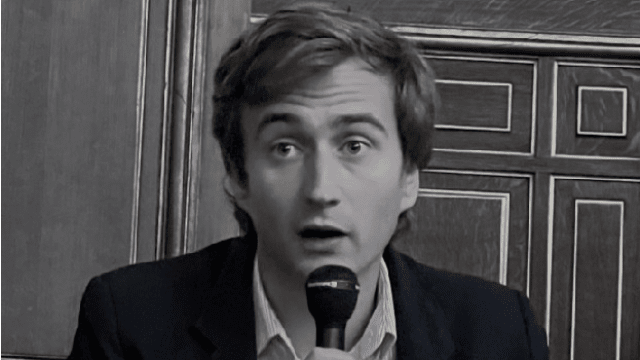Loïc Imberti (E18): ‘NFTs are Shaking Up the Art World’
Auctioneer Loïc Imberti (E18) joined the Danae.io team to support contemporary art projects through the blockchain, NFTs and Web3. He explains how these new technologies offer creative and financial opportunities.
ESSEC Alumni: What led you to work in the art market?
Loïc Imberti: When I started at ESSEC, I also took the auctioneer’s exam and juggled between micro-economics and decorative arts from the Louis XIII period, statistics and lyrical abstractionism during the Second Paris School. My path to a career in the art market was also bolstered by classes in negotiation and Martial Poirson’s class in Arts Management, in addition to the Certificate in Private Law & Economics I obtained from Yale University and Assas.
EA: Can you explain what an auctioneer does?
L. Imberti: An auctioneer is first and foremost an eye which can carry out an initial ‘sorting’ of works before calling on experts according to the period or geographical zone. This task requires a solid grounding in art history and market knowledge, as each speciality fluctuates in line with supply and demand, which is now global. Then there's the ‘business getting’ aspect, which involves negotiating collections, marketing strategy and the project communication plan. For example, when I was working for Artcurial, I had to find a way to promote André Malraux’s collection in a context of relative disinterest in 20th century wars, from the Spanish Civil War to the Resistance, and despite his involvement in trafficking cultural property, particularly in Cambodia.
EA: How would you describe the art auctioneering sector in France?
L. Imberti: The market is structured around the Christie’s - Sotheby’s duopoly, both of which are currently under French ownership (François Pinault and Patrick Drahi respectively) and familiar to the general public thanks to their multi-million record-breaking sales. Then you have the breeding pool of Drouot shareholder auctioneers, which offer more affordable lots.
EA: How does France fare on the international market?
L. Imberti: While France represented 60% of the auction market in the 1960s, housed most of the major collections and specialised in the key avant-gardists from Impressionism to Cubism and Realism, by 2001 it represented just 3% of the world market. There has since been a turnaround, with Paris totalling 7% of global sales in 2023. Paris nevertheless remains a minor capital, a long way behind New York, London, Beijing or Hong Kong.
EA: How do you explain the recovery for Paris?
L. Imberti: Brexit completely altered the market by making trade between the continent and the UK non-EU. Paris benefited greatly from this, not only thanks to British clients who opted to send their collections to the continent, but also to auctioneers who repatriated certain specialities, such as Sotheby’s Paris, which took over Irish Art, previously in London’s hands.
EA: What are the main challenges for the sector at present?
L. Imberti: Auctions offer an exceptional customer experience for the buyer, but fall foul of numerous hurdles, including the mental barrier, limited exhibition time and need to attend in real time, either in person, online, or by telephone. Digital players, such as the Dutch unicorn Catawiki, have used these constraints to shake up the market, by addressing a younger population discouraged by the ceremonial and opaque aspect of traditional auction sales.
EA: Another recent and highly-publicised digital revolution is the explosion of NFTs. What are they?
L. Imberti: An NFT is a non-fungible token, a unique identifier recorded on a blockchain and associated with a smart contract which refers to a digital file (an image, sound or video, etc.). These new objects meet the need for transparency dear to new generations, in addition to investors’ need for greater liquidity of works. There’s a great deal of enthusiasm around NFTs, as the sale of Beeple’s NFT for €69 million at Christie’s goes to show. For the first time, digital creation is gaining market recognition and collectors are willing to acquire without materiality, thus enabling digital artists to live off their work. It’s also good news for asset management, as NFTs offer a way to include what are now considered as ‘non-banking’ assets in an asset investment scheme.
EA: Could you give us some examples of NFT works?
L. Imberti: I’m particularly fond of the artists we represent at Danae.io. Stephan Breuer, for example, creates a bridge between old art (by using frames from the Louvre) and digital art (through iconic games) with his Eternals series. Agoria develops compositions by artificial intelligence with dreamscapes which have nothing to envy of the great masters of abstraction. There’s also Thomas Paquet’s algorithmic works, such as L’Observatoire, which uses a play of colour shading to recreate the position of the sun and moon in real time.
EA: Are there still hurdles to the development of NFT in art?
L. Imberti: The first hurdle is the lack of general public awareness. Generations Y or Z who grew up with internet have a better grasp of NFTs. For those who are less familiar with the preliminary techniques of the web’s workings, this world remains highly obscure and may arouse contempt and hostility. The second hurdle is the speculative frenzy, and the resulting uncertainty tends to worry collectors, not to mention the risks of hacking and phishing which the media delight in reporting on.
EA: Despite these issues, what is the outlook for NFT in art?
L. Imberti: The accessibility of art to the widest audience has been a fundamental issue since the second half of the 19th century, with the emergence of the Arts & Crafts movement, followed by the Art Nouveau group of L’art dans Tout. The digitalisation of art shifts the paradigm in this regard. Today, anyone with an internet connection can view digital works and acquire them at a more affordable price than the majority of physical works.
EA: What services does Danae.io offer in this respect?
L. Imberti: Danae.io explores new forms of contemporary artistic expression by combining art and technology. We support creations which blend innovation, rarity and curation on the Web3. We thus recently worked with the sculptor Kohei Nawa (represented by Pace Gallery) to create an augmented reality environment around his monumental sculpture, Ether (Égalité), and we organised a physical and digital exhibition in the foyer of the Opéra Comique.
EA: You also roll out ‘NFT strategies’ with art market players...
L. Imberti: We recently teamed up with Galerie Roger-Viollet, to which the artist 13 Bis gave free rein to delve into his millions of photographs and use them freely to create collages evoking the artist’s unique brand of surrealism. This world first and decidedly futuristic premise combined an event in the metaverse during the exhibition opening and an NFT sale.
EA: What about your project for the City of Paris?
L. Imberti: In a 2018 survey, the Ministry for Culture classified France’s monuments into four different states: ‘good’, ‘fair’, ‘poor’ and ‘in danger’. The survey concluded that 23.3% of the monuments inspected were in a poor state or in danger. In this context, the City of Paris asked for our assistance with their very first NFT project for heritage promotion, around the restoration of Saint-Etienne-du-Mont church. The artist Claire Adelfang, who exhibited at the Thaddaeus Ropac gallery from 2012 to 2019 and worked with Versailles Palace and the Paris Opera, will do in-situ work in the church, resulting in physical prints and NFTs combining visuals and sound recordings which will also offer patronage benefits. We will sell everything at an auction in the 5th arrondissement city hall during the Heritage Days, and the funds raised will go to the restoration of the monument’s stained-glass windows. We hope to generalise this initiative across the region in the long term and with a network of emerging artists, including graduates of Fine Arts schools.
EA: So the idea is thus to promote heritage as much as contemporary creation?
L. Imberti: Exactly. Our aim is to create bridges, just as André Malraux envisaged. We believe that forming synergies between heritage and contemporary art through digital technology is a wonderful way to transmit art from generation to generation.
Interview by Louis Armengaud Wurmser (E10), Content Manager at ESSEC Alumni
Do you want more quality content about the ESSEC community? Join us now!

Comments0
Please log in to see or add a comment
Suggested Articles



